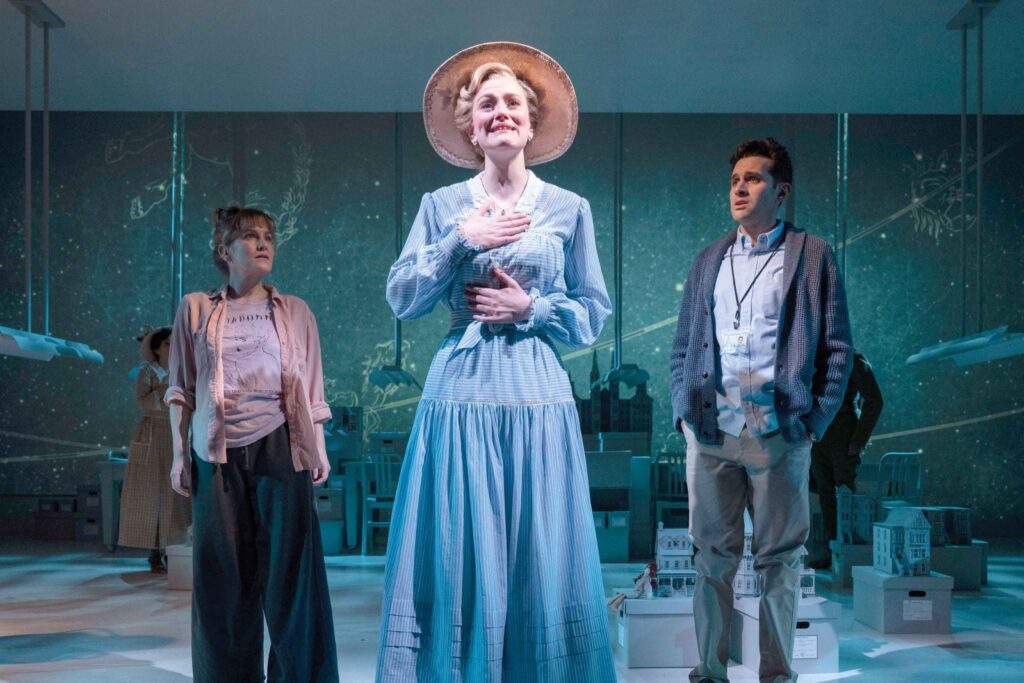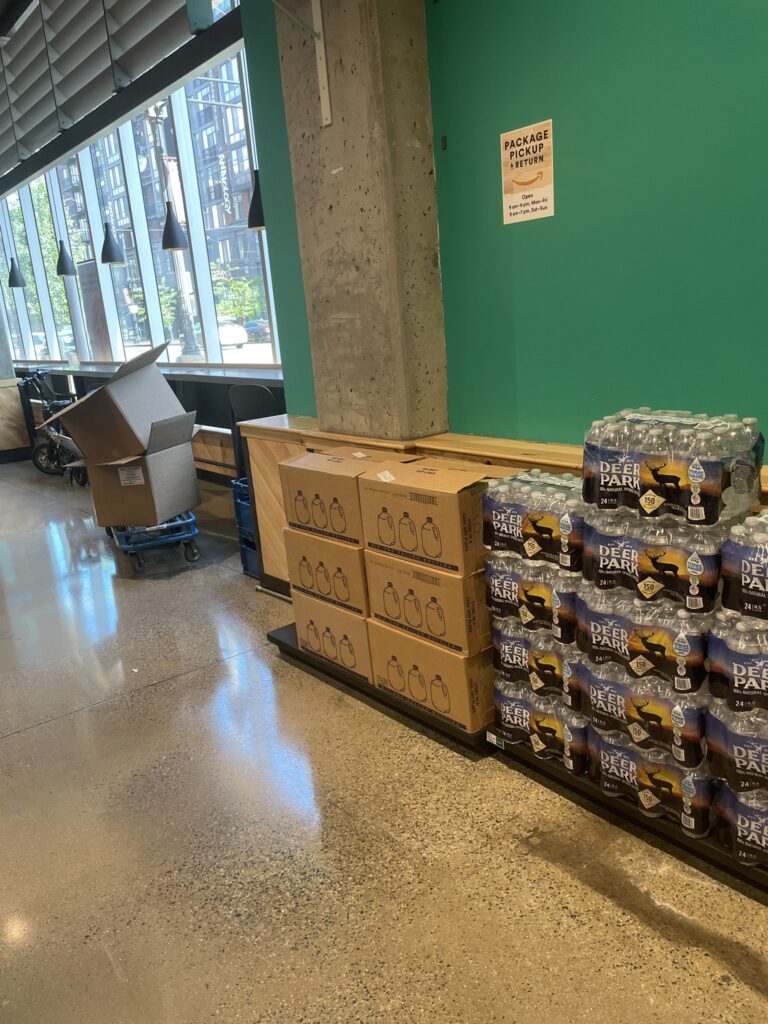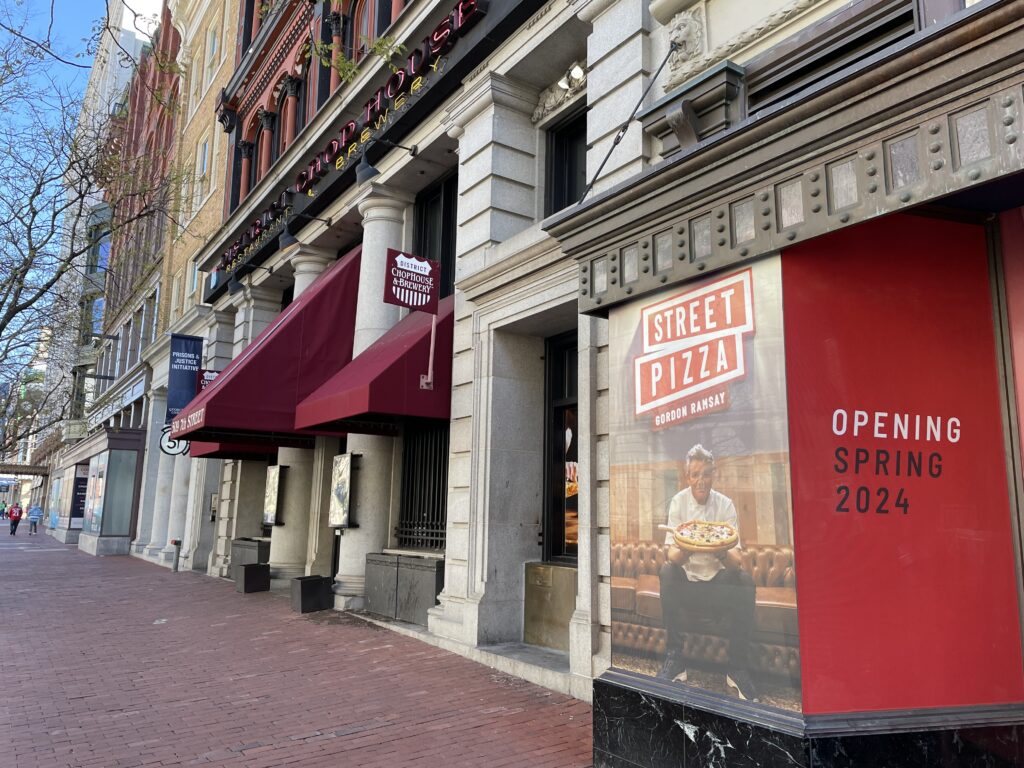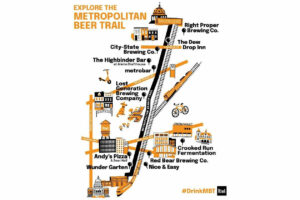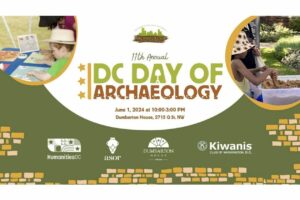Streets of Washington, written by John DeFerrari, covers some of DC’s most interesting buildings and history. John is the author of Historic Restaurants of Washington, D.C.: Capital Eats, to be published this September by the History Press, Inc. John is also the author of Lost Washington DC.
One of the country’s most sophisticated scientific laboratory complexes, the National Bureau of Standards, once stood on a hill off of Connecticut Avenue at Upton Street, in the serene, semi-rural upper Northwest section of the city. Through much of the 20th century, this secluded and unassuming enclave quietly made countless important contributions to the safety and quality of the manufactured goods we take for granted today, including everything from airplane engines to kitchen crockery.
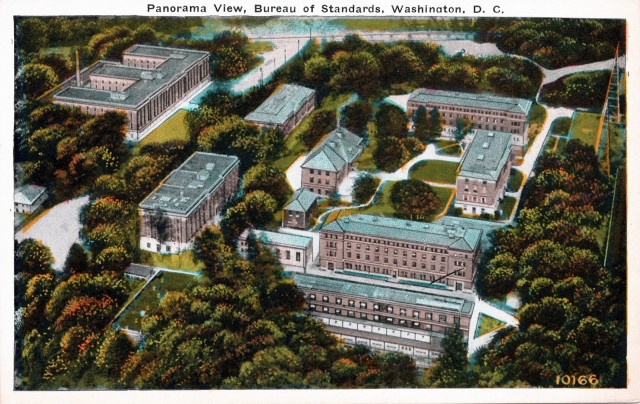
Connecticut Avenue runs along the top of this circa 1930 view of the Bureau’s campus (Author’s collection).
The Bureau was founded in 1901, during a period of burgeoning industrial production and dramatic technological change. Telephones, automobiles, light bulbs, electrical machinery—it all needed practical, reliable standards based on methodical scientific testing. The new Bureau filled this need, greatly expanding on the mission of its predecessor, the Office of Weights and Measures, which had been set up in the Treasury Department in the early 19th century to ensure that standard measures were used when calculating customs duties on imported goods.
First housed temporarily in the old Office of Weights and Measures building on Capitol Hill, the fledgling Bureau in 1901 urgently needed space to build its own laboratory. The requirements were exacting. The laboratory had to be well outside the city proper, somewhere completely free from vibration, traffic disturbances, and the electrical interference caused by streetcar lines. It had to be solidly built, using twice the construction materials of an ordinary office building, heating and plumbing lines that were twice as complicated as an average building’s, and four or five times the usual amount of wiring. Some labs were to be fitted out with both running salt water and fresh water as well as dispensed crushed ice. Ancillary buildings would also be needed for engines, pumps, heavy machinery, and the fabrication of sensitive scientific instruments.
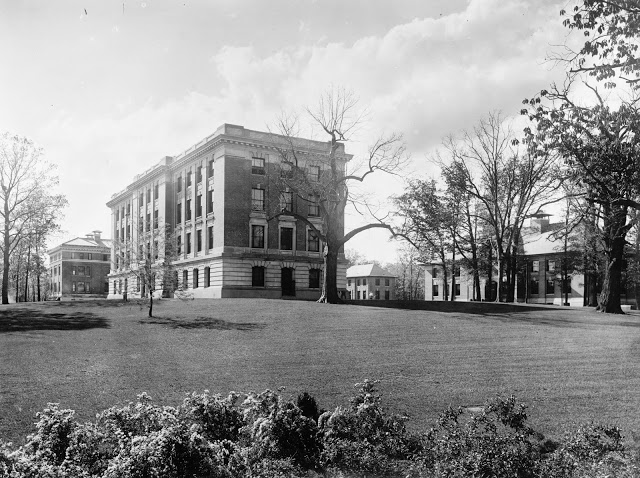
The South building dominates this early view of the NBS campus. The original (North) building is on the right (Source: Library of Congress).
In November 1901, the Bureau’s first director, Dr. Samuel W. Stratton (1861-1931), signed a contract for $25,000 with the Chevy Chase Land Company to acquire part of the old Vineyard and Springland Farm in Northwest to be the Bureau’s new home. The site was near Connecticut Avenue but set back from it so as to be free of the noise and interference of the street. This part of the District was still quite rural at the time, dotted with small farms and dense woods, with deep valleys harboring winding creeks and streams. Connecticut Avenue, graded and with a streetcar line out to the fledgling suburb of Chevy Chase, was the only sign of development between Cleveland Park and the Maryland border. Primary access to the Bureau’s new site was via an erratically winding old dirt path, called Pierce Mill Road, which had been used by farmers to bring their grain down to Peirce Mill on Rock Creek for grinding.
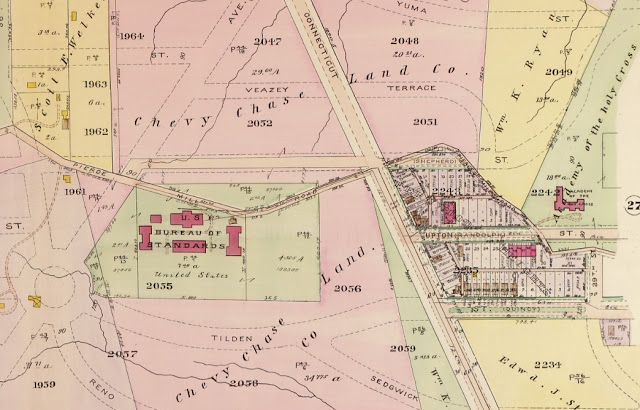
A Baist real estate map from 1913 shows the early campus and the winding Pierce Mill Road, which was eventually straightened and replaced by Van Ness Street. (Source: Library of Congress).
Construction was slow and difficult, what with all the specialized features and heavy machinery that were to be installed at the remote location. In the Bureau’s official history, Measures For Progress (1966), Rexmond C. Cochrane writes:
The teams of horses under their heavy loads had to rest frequently on the long grade uptown and more often still as they struggled up the steep of Pierce Mill Road, the dirt track through the woods, to the top of the hill. Four- and eight-horse teams were frequently needed to haul building materials up the height, and it is possible that some of the big equipment for the mechanical building may even have required a 16-horse hitch.
The first two buildings, the North and South buildings, were completed in 1903 and 1904. By 1913, East and West buildings joined them to form a very academic-looking quadrangle perched at the crest of the hill (the site is now a small park just south of Van Ness Street along International Drive). These distinguished Neoclassical Revival buildings were clad in dark red pressed brick and trimmed in Indiana limestone, with Spanish tile roofs. The prestigious firm of Wood, Donn & Deming, which had designed the magisterial Masonic Temple downtown and other notable structures, was responsible for at least some of these elegant structures.
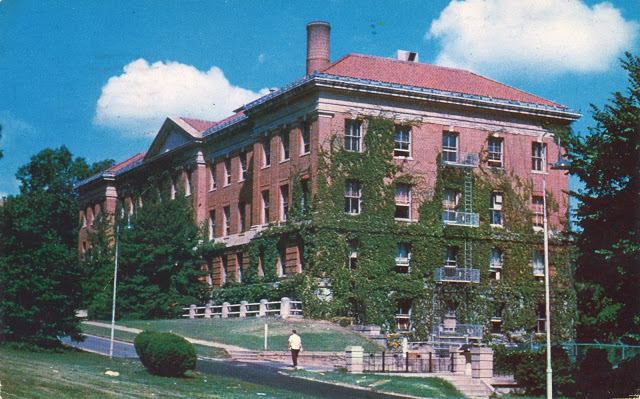
The Chemistry Building, circa 1957 (Author’s collection).
In 1916, a new Chemistry Building, located just to the northeast of the original cluster of buildings, was completed. Waddy B. Wood (1869-1944), the architectural firm’s best-known partner, had left in 1912 to work independently, leaving Edward W. Donn, Jr. (1868-1953) and William I. Deming (1871-1939) to collaborate on the Chemistry Building, which they designed to match the style of the earlier buildings. Deming, a native Washingtonian, would continue designing buildings for the Bureau into the 1920s. The Bureau’s land holdings would gradually expand to cover some 70 acres on both sides of Van Ness Street adjacent to Connecticut Avenue, with almost 90 buildings scattered over the sprawling complex.
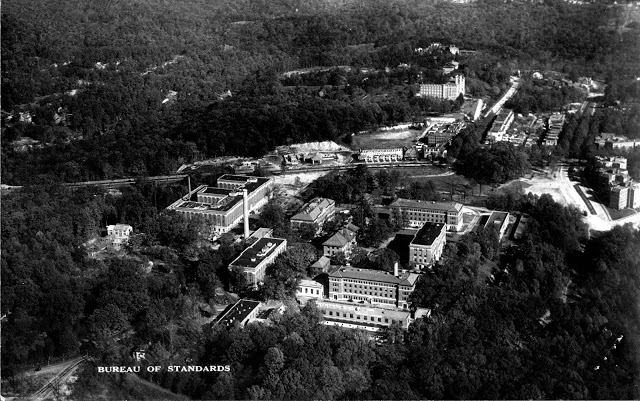
Another circa 1930 view, with Connecticut Avenue running horizontally across the middle, with north to the left. (Source: National Institute of Standards and Technology Library)
The Bureau undertook a wide variety of measurement, testing, and standards-setting activities, and the geeky appeal of this esoteric work fascinated observers from the start. In a 1903 article entitled “Wonders of Measurement,” the Washington Post marveled that the Bureau’s “employees think nothing of measuring the weight of the grime from your thumb which you may place on a clean sheet of paper. They have the instruments and need only to weigh the sheet before the grimy thumb is applied and then after.” The Post reporter with the dirty hands went on to discuss how the Bureau’s scrupulous measurements had settled disputes about such things as whether a farmer’s milk containers really held the amounts he advertised.
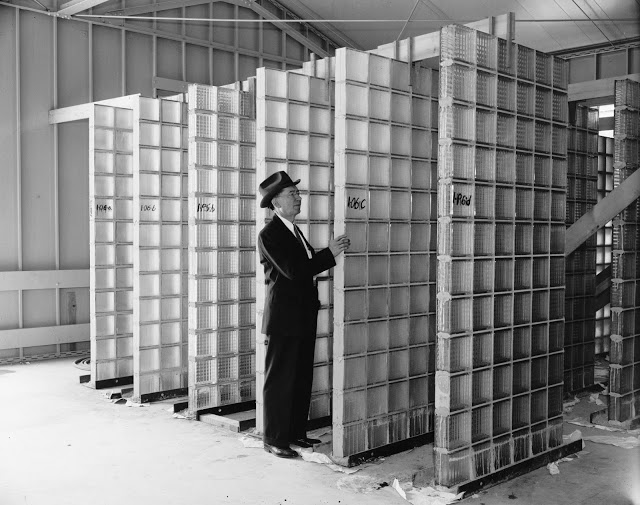
Testing glass building blocks in 1938 (Source: Library of Congress).
The range of the Bureau’s measuring instruments was as astonishing as the breadth of its activities. As the National Geographic marveled in 1915, one thermal instrument was so sensitive it could be thrown off by the heat from the presence of its operator. Another was “so delicately adjusted that it shows the loss of weight due to the reduction of the earth’s attraction when two pieces of metal are weighed one upon another instead of side by side.” On the opposite extreme in the engineering laboratory were a “huge testing machine which can tear apart the strongest steel girders used in building great skyscrapers,” furnaces hot enough to melt tungsten or titanium, and chillers cold enough “to liquefy the very air we breathe.” Testing with such machines helped calibrate instruments used in the steel, glass, and ceramics industries, among others.
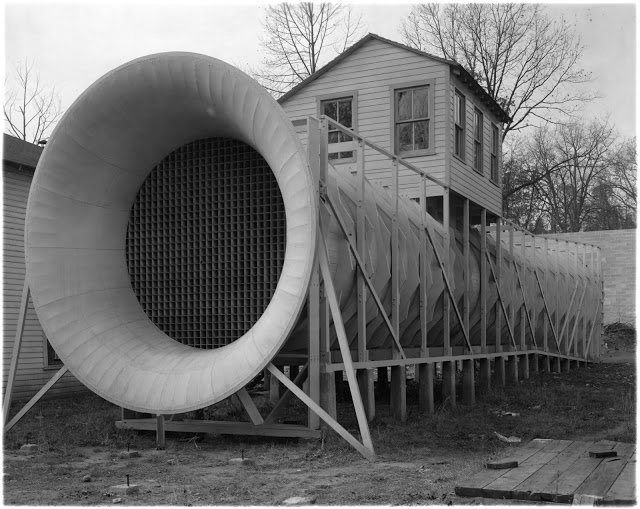
One of the Bureau’s wind tunnels for aeronautical research (Source: National Institute of Standards and Technology Library).
Aeronautical research was a high priority, and the Bureau eventually had its own wind tunnels built just north of Van Ness Street to test airplane designs. In 1918 the Bureau obtained a new all-metal airplane for testing, and President Wilson was invited to come out to the lab on a Sunday to see it. He, Mrs. Wilson, and Commerce Secretary William Redfield did so, but due to a misunderstanding the building was locked and no one around to open it. Determined to achieve what he had set out to do, Wilson found an open window and, with the help of Secretary Redfield, he and Mrs. Wilson boosted themselves into the lab to inspect the curious new invention.
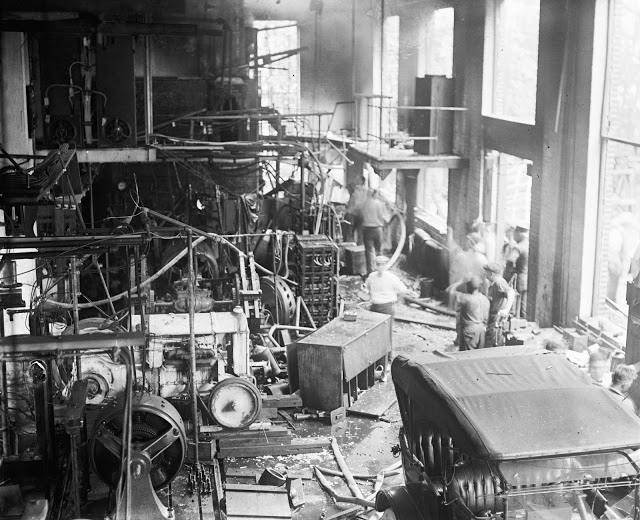
The wrecked dynamometer lab, September 20, 1923 (Source: Library of Congress).
Some of the Bureau’s aeronautical testing could be quite dangerous. On the afternoon of September 20, 1923, technicians in the Bureau’s dynamometer laboratory were busy testing airplane motors to see how much gasoline evaporates during flight, an experiment that everybody seemed to agree was risky but important. Suddenly an engine being tested in the altitude chamber backfired, setting off a massive explosion. The chamber’s 10-inch concrete walls were shattered, and the whole laboratory was a wreck. The blast blew out all 18 of the lab’s large windows, spewing shards of glass as far as 50 feet from the building. Four men were killed and six others seriously injured. Upbeat Bureau officials had the wrecked lab repaired and brought back into service in short order. The march of progress was not to be stopped.
Another important focus was radio technology. Among the scientists on the Bureau’s staff in the 1920s was Grace Hazen, “one of very few women who are radio engineers,” according to a 1925 article about her in the Washington Post. The daughter of a meteorologist, Hazen grew up with a love of scientific work and joined the bureau after graduating from college. Her job was to work on the standardization of frequency meters used to measure radio waves. Hazen conceded that she really enjoyed the construction of radios more than actually listening to them, and generally only did so when on vacation. “I have built myself a small portable with which I can pick up plenty of amusement,” she declared.
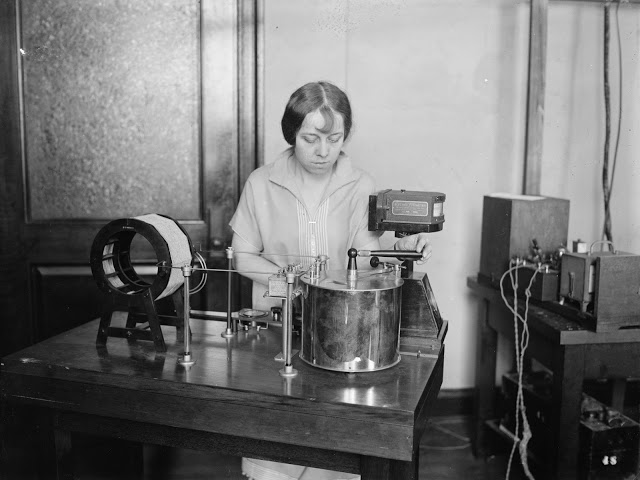
Grace Hazen tests radio wavelengths in 1925 (Source: Library of Congress).
The labs on the hilltop were a popular sightseeing destination in the 1930s, with tours being offered on a daily basis. By 1940, however, all of that changed. The NBS became a closed research facility largely focused on military technology. A year later the block of Van Ness Street that now ran through the middle of the Bureau’s campus would be closed to public traffic, irking nearby neighbors. Meanwhile, the National Defense Research Committee had signed an agreement with the Bureau to test and develop proximity fuzes for rockets, bombs and mortar shells. The urgent new assignment fell to Dr. Harry Diamond (1900-1948), head of the Bureau’s electronics division. Under Diamond’s leadership, the proximity fuze was perfected and became a decisive military asset as the U.S. entered the war. A large laboratory complex devoted to fuze and other missile technologies was constructed on the north side of Van Ness Street during and after the war. In 1953 this part of the bureau was transferred to the Army and eventually renamed the Harry Diamond Laboratories.
By the late 1950s, the Bureau was reaching new heights in scientific research. In late 1956 scientists at the Bureau conducted a groundbreaking experiment proving that parity is not always conserved in physical processes, toppling a long-held assumption. The breakthrough won the Nobel Prize in Physics for the theorists behind the experiment. Despite prestigious results such as this, Bureau officials were increasingly feeling confined by the aging structures of the Van Ness campus. A decision was made to move to more spacious quarters near the Atomic Energy Commission’s planned facilities in Gaithersburg, Maryland, far from the encroaching city. The Bureau’s director testified to Congress in 1956 that the Van Ness location was no longer tenable, in part because it was “extremely vulnerable in the event of an atomic attack.” Why Gaithersburg would be less vulnerable is not clear, but the vast, former pastureland there had the same bucolic appeal that had originally brought the Bureau to the Van Ness site half a century earlier.
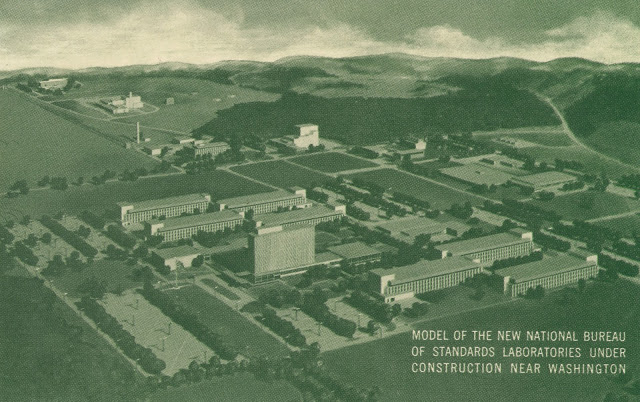
An early 1960s model of the Bureau’s planned Gaithersburg campus (Author’s collection).
Once the Bureau was set to move out, there was much wrangling over who would get the old campus. Several federal agencies studied the site but decided not to move in. The Army’s Harry Diamond Laboratories wanted to stay but were told they had to move too. In the early 1970s the labs moved to Adelphi, Maryland, where they are now the Army Research Laboratory. The Washington Technical Institute, established in 1966 as a vocational-technical training school for D.C. residents, opened in 1968 on the northeastern portion of the old campus, taking over several of the old NBS buildings as its first classrooms. Those buildings were replaced by new brutalist structures in the mid 1970s, and in 1977 the Institute was folded into the newly established University of the District of Columbia, which occupies the space today as its main campus. The rest of the site was turned over to the State Department for use as an international enclave and was gradually filled with large new embassy buildings as well as the headquarters of the Intelsat consortium.

A State Department building at the International Center (photo by the author).
Astonishingly, none of the Bureau’s historic buildings were preserved, not the original pair of buildings designed by Wood Donn & Deming and so arduously constructed in the early 1900s, not the Low Temperature Building where the historic parity experiment was conducted in 1956, not even the stately Chemistry Building, which could have so easily been repurposed as office space. The Secretary of Commerce, required under Section 106 of the National Historic Preservation Act to assess the historic value of the NBS structures, determined that not a single one of the 90 structures on the 70-acre campus had any historic significance at all, an outrageous assertion that would be inconceivable today.

A former National Bureau of Standards entrance gate (photo by the author).
The resulting destruction of the Bureau’s buildings has left very little to memorialize the many scientific and technical achievements that were made on this ground. One State Department building within the International Center is designed in a style that vaguely recollects the original NBS buildings. In the small park on top of the hill, a lone apple tree with a plaque beneath it also serves to commemorate the lab’s heritage. And down on Connecticut Avenue two stone pillars and a curb cut leading to nothing are all that remain of one of the Bureau’s old entrance gates. They look lost and forlorn in a world that has forgotten what they were there for.
* * * * *
Special thanks to Keith Martin, Research Librarian at the National Institute of Standards and Technology (NIST), for his invaluable advice and assistance. (NBS was renamed NIST in 1988). Additional sources for this article included Rexmond C. Cochrane, Measures For Progress: A History of the National Bureau of Standards (1966); Margery L. Elfin, Paul K. Williams, and the Forest Hills Neighborhood Alliance, Forest Hills (2006); William C. Redfield, With Congress and Cabinet (1924); and numerous newspaper articles.
Recent Stories
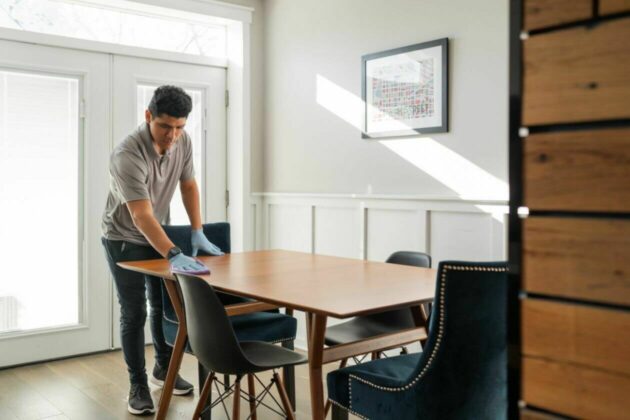
For many remote workers, a messy home is distracting.
You’re getting pulled into meetings, and your unread emails keep ticking up. But you can’t focus because pet hair tumbleweeds keep floating across the floor, your desk has a fine layer of dust and you keep your video off in meetings so no one sees the chaos behind you.
It’s no secret a dirty home is distracting and even adds stress to your life. And who has the energy to clean after work? That’s why it’s smart to enlist the help of professionals, like Well-Paid Maids.

Unlock Peace of Mind for Your Family! Join our FREE Estate Planning Webinar for Parents.
🗓️ Date: April 25, 2024
🕗 Time: 8:00 p.m.
Metropolitan Beer Trail Passport
The Metropolitan Beer Trail free passport links 11 of Washington, DC’s most popular local craft breweries and bars. Starting on April 27 – December 31, 2024, Metropolitan Beer Trail passport holders will earn 100 points when checking in at the
DC Day of Archaeology Festival
The annual DC Day of Archaeology Festival gathers archaeologists from Washington, DC, Maryland, and Virginia together to talk about our local history and heritage. Talk to archaeologists in person and learn more about archaeological science and the past of our


